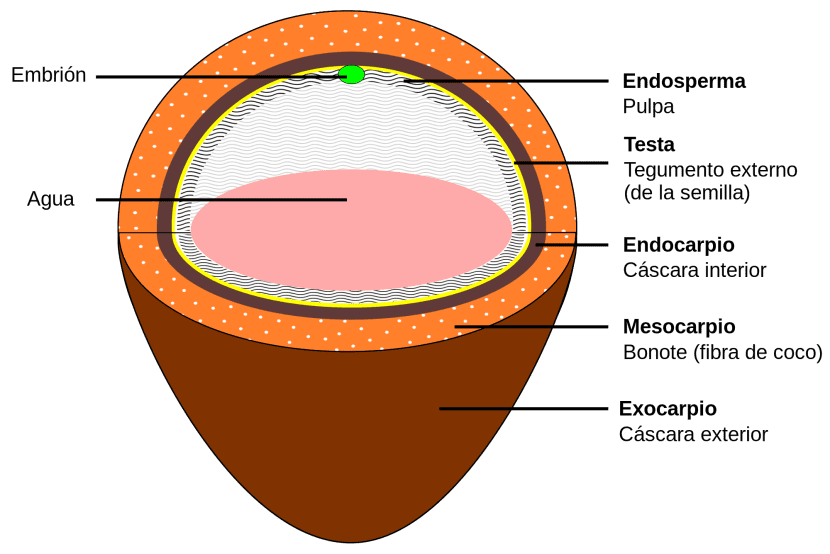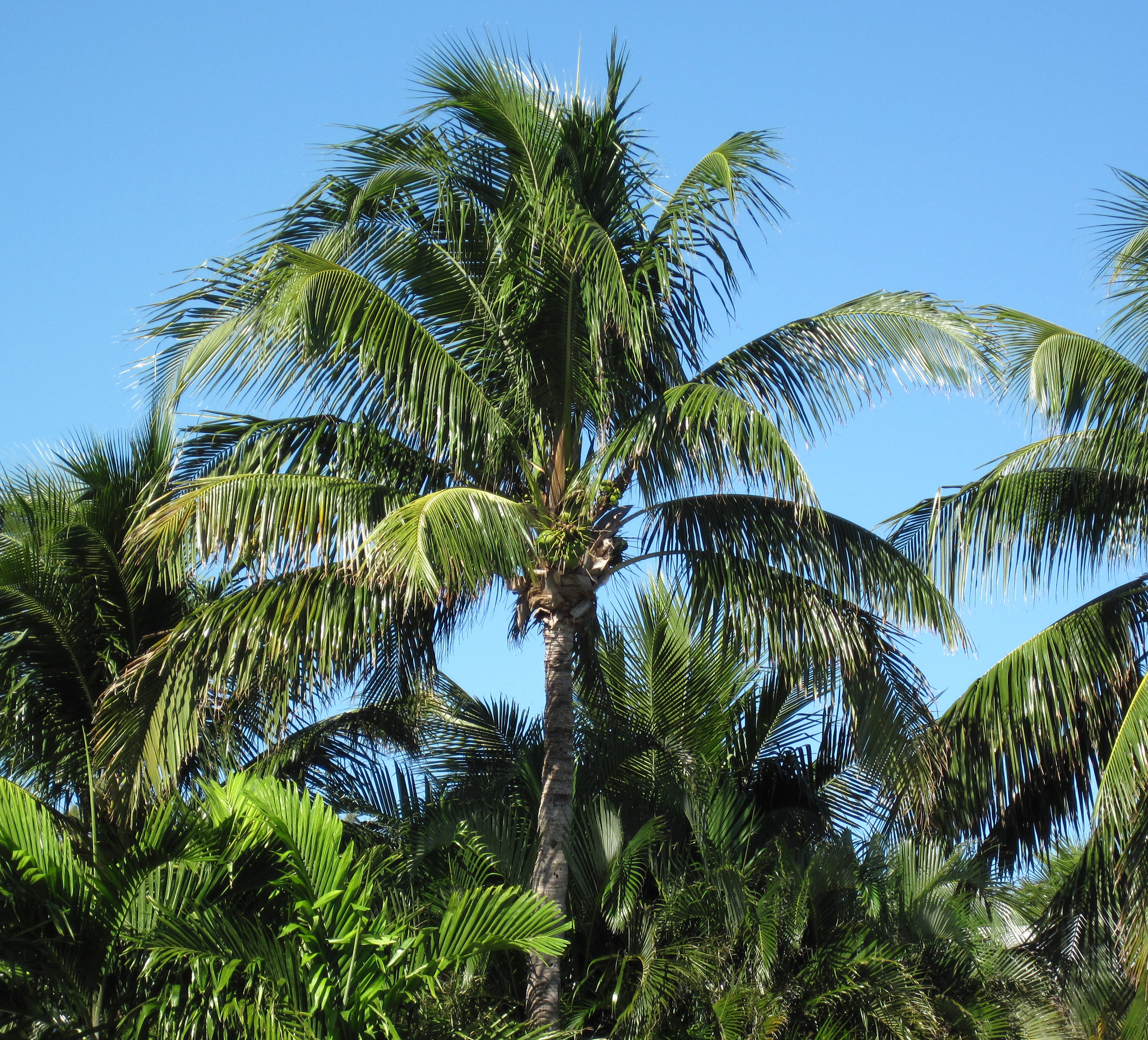
El coconut tree it is one of the most popular palm trees. It is the symbol of the tropical climate, and there is no one who does not want to have one in their garden. However, in temperate regions it is really difficult to get a specimen to reach an adult, since unfortunately it is a species very sensitive to cold.
Even so, the plants obtained from seed are much more resistant than those acquired when they are seedlings, because a seed that germinates in our home will have no choice but to get stronger quickly if it wants to survive; instead, the grown plants have been grown in greenhouses under conditions that have been suitable for them from the beginning. With that said, let's see how to plant a coconut.
When is the coconut planted?
El coconut tree it is a plant whose seed needs heat and humidity. For this reason, when the climate is tropical and it also rains frequently, it can be sown at any time of the year; Nevertheless, in temperate regions it will only be possible in spring or, even better, in summer, which will be when temperatures exceed 20ºC, and even 30ºC in many places.
It could also be done in autumn or winter, but I don't recommend it unless you have a germinator with a temperature regulator to keep it around 25ºC, or a reptile incubator (no kidding. Incubators are the best seed germinators palm tree, since you can maintain the ideal temperature, something that favors its germination).
How to choose a coconut

The coconuts, when they finish maturing still in the palm tree, are surrounded by a hard outer shell of brown-orange color. Inside it is the seed, what we call 'coconut', which has a rounded shape and is covered by yellowish-brown fibers. Well, as we know, what is imported is the peeled fruit, without the peel. However, How can you tell if it is viable or not?
To check this, we have to make sure that it's not soft, by no area. What's more, we also have to leave those that look bad, that is to say, that they have fungi, something that we will know if we see that they have whitish or pink spots or dust.
How to germinate a coconut

As you can see in the image, the coconut has three rounded dark brown almost black dots. From any of the three, the first root of the palm tree can come out, which is why they are known as germination points. These must be seen intact, since otherwise it would be indicating that the plant has already tried to germinate, leaving the seed unviable.
Once we have chosen our coconut, we will plant it in a pot wide enough so that it can fit well, in a very porous substrate. It is highly recommended to use equal parts perlite with vermiculite, to give you an excellent start. We will always keep it moist but not wateryWell, it could rot.
Our coconut will germinate in 1-2 months, as long as the temperature is between 25 and 35ºC. So you already know, put it near a heat source to wake up soon 🙂.
When is a coconut tree transplanted?
If we have been lucky and the coconut has germinated, we will quickly realize that it grows fast during spring and summer, but slow in autumn and especially in winter. In fact, the normal thing is that their growth stops when the temperature drops below 15ºC. It is very, very important to protect it from the cold, since if it drops to 5 degrees we will lose it.
Taking all this into account, the ideal is not to change it pot during the first twelve months after sowing. First we have to see that it acclimates well, that it grows healthy, that it takes root. A transplant done too soon could be fatal. What's more, it shouldn't be transplanted the second year either, unless roots grow out of the drainage holes in the pot. In this case, it should be done in spring.
How is it transplanted?
The step by step that I advise to follow is this:
- First, you have to choose a pot that is about four inches wider and deeper than the one you have now. This must have holes in its base, but it can be of the material you prefer (plastic, clay).
- Afterwards, it is interesting to add a layer of clay, volcanic clay or the like.
- Next, fill the pot a little less than half full with a mixture of peat moss and 30% perlite.
- Then, extract the coconut tree from the old pot, and insert it into the new one. In the event that it is too high or too low, feel free to remove or add more substrate as appropriate. If you still have the coconut, leave it, and do not bury it completely; when it is no longer necessary, the plant itself will get rid of it (ceasing to feed it, which will cause the death of the stem that connects it to the palm tree).
- Finally, finish filling and water.
Now, put it in an area with light, and enjoy it.
Coconut cultivation in Spain, is it possible?

Image - Flickr / Forest & Kim Starr
I did not want to finish this article without first talking a little about the cultivation of the coconut tree in Spain. I myself have bought two seedlings, because I thought that by living in an area where there are frosts but they are very weak and punctual, I could survive ... But reality prevails in the end. The palm trees that are sold are very spoiled; I mean, they've had heat and humidity, plus compost, from when they germinated to when they were put up for sale in the nurseries, so once you take them home or out to the garden, they'll be fine until the cold returns. Then the tips of the leaves will turn brown; then all the leaves will dry up, and finally it will die.
El Cocos nucifera It is a species that wants temperatures above 18ºC, high humidity, and sun.. In Spain it only survives in some parts of the Canary Islands, and it could be tried on the Costa Tropical of Malaga. Of course, also in greenhouses that have their temperature and humidity regulator.
So if you see any for sale, I am very afraid that you will only be able to grow it as if it were a seasonal plant, which is a shame, because the life expectancy of this palm tree is 100 years.
There is no information on the germination of the Paraguayan coconut
Hi Emanuel.
The steps to follow are the same for all varieties of coconut.
A greeting.